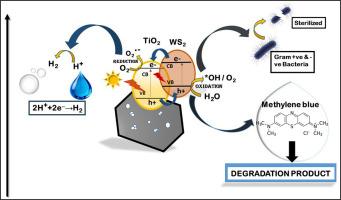WS2-integrated TiO2/soot: A novel multifunctional nanocomposite for synergistic dye degradation, photocatalytic hydrogen evolution and antibacterial applications
IF 6.3
2区 材料科学
Q2 CHEMISTRY, PHYSICAL
引用次数: 0
Abstract
Herein, we have reported a novel multifunctional nanocomposite consisting of WS₂@TiO₂/soot that exhibits enhanced photocatalytic degradation of methylene blue (MB) dye under UV illumination along with photocatalytic water splitting and significant antibacterial activity. Although TiO₂ is a widely used photocatalyst, its UV-limited activity due to a wide band gap (∼3.2 eV) is enhanced by WS₂ and soot, which extend visible-light absorption, improve charge separation via heterojunction formation, and boost photocatalytic efficiency through electron mediation, dye adsorption, and light scattering. Comparative photodegradation studies using TiO₂, TiO₂/soot, and WS₂-assisted TiO₂/soot nanocomposites (designated as WTS1 and WTS3) revealed significantly improved degradation efficiencies. The WTS1 and WTS3 composites achieved degradation efficiencies of 95.25% and 90.66%, respectively, within 30 minutes, outperforming the other systems. Mechanistic studies indicated hole mediated degradation of pollutants via Z-scheme pathway. Photocatalytic H2 generation efficiency for the catalyst was also assessed using Na₂S and Na₂SO₃ as sacrificial agent under solar irradiation (λ > 250 nm). The catalyst demonstrated an excellent H2 evolution rate of 5.89 mmol h⁻¹ g⁻¹ without saturation and also exhibited remarkable stability. On the other hand, in antimicrobial spot-assays against three Gram-negative (Escherichia coli, Pseudomonas aeruginosa, Klebsiella pneumoniae) and three Gram-positive (Staphylococcus aureus, Staphylococcus epidermidis, Bacillus cereus) reference strains, WS₂/TiO₂-soot (WTS1) achieved 100 % inhibition of radial colony growth under both 253 nm and 365 nm UV irradiation at all time points (24, 48 and 72 h). These results underscore the synergistic effects of the composite components and highlight the potential of WS₂-assisted TiO₂/soot systems as highly efficient, visible-light-responsive photocatalysts for environmental remediation.

ws2集成TiO2/soot:一种具有协同染料降解、光催化析氢和抗菌应用的新型多功能纳米复合材料
在此,我们报道了一种由WS₂@TiO₂/烟尘组成的新型多功能纳米复合材料,该复合材料在紫外线照射下对亚甲基蓝(MB)染料具有增强的光催化降解能力,同时具有光催化水分解和显著的抗菌活性。虽然TiO 2是一种广泛使用的光催化剂,但由于其宽带隙(~ 3.2 eV),其限紫外活性被WS 2和烟尘增强,从而扩大可见光吸收,通过异质结的形成改善电荷分离,并通过电子中介、染料吸附和光散射提高光催化效率。利用tio2、tio2 /soot和WS₂辅助tio2 /soot纳米复合材料(称为WTS1和WTS3)进行的光降解比较研究表明,tio2 /soot纳米复合材料的降解效率显著提高。WTS1和WTS3复合材料在30分钟内的降解效率分别达到95.25%和90.66%,优于其他复合材料。机理研究表明,孔介导的污染物降解是通过z方案途径进行的。在太阳辐射(λ > 250 nm)下,以Na₂S和Na₂SO₃为牺牲剂,对催化剂的光催化制氢效率进行了评价。该催化剂表现出良好的氢发展速率(5.89 mmol h -⁻¹g -⁻)和稳定性。另一方面,在对3株革兰氏阴性菌株(大肠杆菌、铜绿假单胞菌、肺炎克雷伯菌)和3株革兰氏阳性菌株(金黄色葡萄球菌、表皮葡萄球菌、蜡样芽孢杆菌)进行的现场抗菌试验中,在253 nm和365 nm紫外照射下(24、48和72 h), WS₂/TiO₂-soot (WTS1)对径向菌落生长的抑制均达到100%。这些结果强调了复合组分的协同效应,并突出了WS₂辅助tio2 /烟灰体系作为高效、可见光响应的环境修复光催化剂的潜力。
本文章由计算机程序翻译,如有差异,请以英文原文为准。
求助全文
约1分钟内获得全文
求助全文
来源期刊

Surfaces and Interfaces
Chemistry-General Chemistry
CiteScore
8.50
自引率
6.50%
发文量
753
审稿时长
35 days
期刊介绍:
The aim of the journal is to provide a respectful outlet for ''sound science'' papers in all research areas on surfaces and interfaces. We define sound science papers as papers that describe new and well-executed research, but that do not necessarily provide brand new insights or are merely a description of research results.
Surfaces and Interfaces publishes research papers in all fields of surface science which may not always find the right home on first submission to our Elsevier sister journals (Applied Surface, Surface and Coatings Technology, Thin Solid Films)
 求助内容:
求助内容: 应助结果提醒方式:
应助结果提醒方式:


